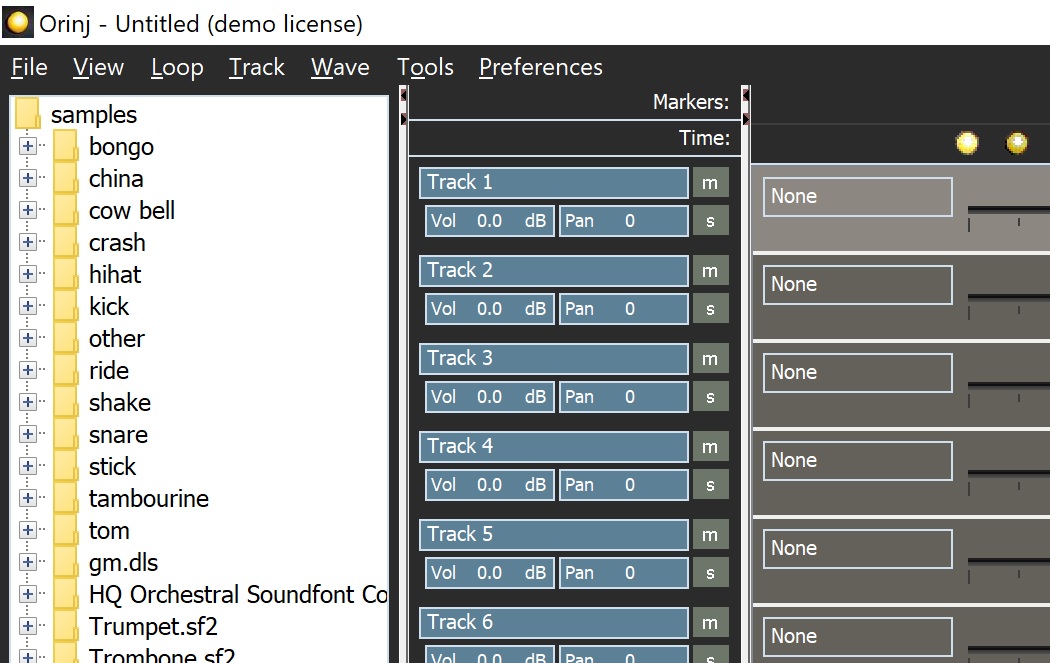Orinj version 7.0.0
The loop building view contains and controls your drum loops. These are short sound pieces. The are called loops, because they can be mixed in a way that allows placing multiple repetitions of the same piece one after the other, as if the piece is looped several times.
Loops are created by choosing and ordering wave samples and Downloadable Sounds (DLS) and SoundFont (SF2) instruments.
A portion of the loop building view is shown on the picture below. To see this view (in case you are looking at another view), click on View and then on Loop Building View in the menu or click on the loop building view button ( ) of the view toolbar.
) of the view toolbar.

Functionality
The following are examples of things you can do in the view.
- You can drag and drop samples, DLS instruments, and SF2 instruments onto tracks.
- You can open the existing loops provided with the Orinj installation. You can modify these loops.
- You can mix loops into wave files, which you can then insert into your multitrack session. (You can also insert loops directly into your session).
- You can play, pause, stop, fast forward, and rewind.
- You can mute tracks, solo tracks, and change the volume and pan of tracks. You can reorder tracks.
You can add loop files to the multitrack session without first mixing these loops to wave files. There is a difference between including a loop into the session and including the mix of a loop into the session. A loop can be edited in the loop building view. A loop mix (the resulting wave file) cannot the edited. If it must change, then it must be removed from the session, a new mix must be created, and the new mix must be inserted in the session.
If you make changes in this view to the loop files included in your session, these changes will automatically be reflected in the corresponding loop files in the session.
Loop building menu
See Orinj Loop building menu. The menu is at the top of Orinj. It contains the commands that allow you to perform the tasks listed above.
Marker line and time line
The following are the two panels under the menu.
- The marker line allows you to add markers at various points in your loop with comments about that loop.
- The time line allows to figure out where you are in the loop during playback.
Wave, DLS, and SF2 sample tree
The tree in the left portion of Orinj shows the folder structure of the "../samples/" folder of the Orinj installation and the contents of any DLS and SF2 files that you added. This tree contains the samples that you can use. You can drag these samples and instruments to any of the loop tracks in the right portion of Orinj.
Tracks
The tracks take the largest portion of the view, under the time line. The actual tracks to the right display the loop hits. It shows you what wave sample, DLS instrument, or SF2 instrument is used for the track hits and where hits are in the loop. In the picture below, for example, the track uses the wave sample for a Yamaha 14x10 inch snare and the snare is hit on the 2 and 4 of a 4/4 loop (with ticks shown at every 1/8 note).

Each track comes with a track control panel, located to the left of the track. The track control panel helps in controlling the track in the overall mix. You can use this panel to change the title, volume, and pan of the track and to solo or mute the track.
Standard toolbars and panels
The following toolbars and panels exist in all views of Orinj.
- The buttons of the player toolbar allow you to play, stop, pause, record, rewind, and fast forward.
- The buttons of the zoom toolbar allow you to zoom in and out of your session or file. (There is no zooming in the loop building view).
- The current time panel shows the current time (during playback).
- The buttons of the view toolbar allow you to switch between the views of Orinj.
- The buttons of the pointer toolbar allow you to select the mouse pointers for various operations. Some pointers help you move objects, while others are designed for selection and drawing. (This toolbar is not used in the loop building view).
- The view times panel shows time information about your loop, view, and selection.
At the bottom of Orinj, you can see the CPU usage bar (the label "CPU: 0%"). During playback and recording, this bar shows you how strenuous playback and recording are on your computer.
Add new comment